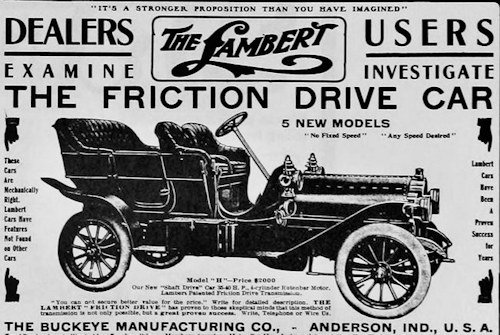Lambert (Buckeye Manufacturing Company)
Automotive manufacturer of Union City, Ohio and Anderson, Indiana, United States from 1905 to 1917.

The Lambert Brothers and Company as Buckeye Manufacturing Company was a manufacturing company that originally made parts for small wagons and later Automobiles as Lambert.
History
The Lambert automobile and Lambert truck were built by the Lambert Automobile Company as an American vehicle from 1905 through 1916. The early motors were built at the Lambert factories of the Buckeye Manufacturing Company and later they were outsourced to other proprietary manufactures.
The company was originally founded in Union City, Ohio in 1884 as Lambert Brothers and Company. In the early 20th century, they put the Buckeye gasoline buggy and parts for the Lambert Automobile Company and the Union Automobile Company. One of its subsidiaries was the Pioneer Pole and Shaft Company, which was headed by George A. Lambert, the son of founder John W. Lambert. Other affiliates were the Union Automobile Company, the Lambert Automobile Company and the Lambert Gas and Gasoline Engine Company, which were headed by John W. Lambert himself. Originally, yokes were made for buggies and other wagon parts. The company employed six workers and a few boys as helpers. After a few years, the company name was changed to JH Osborne and Company. Then some tools were added to the assortment. The company developed a hand-operated drill that bore the name of this company. In 1890 Mr Osborne left the company, which then reverted to its original name. In 1891, the Buckeye Manufacturing Company burned down. The damage to buildings and goods amounted to $ 15,000, of which $ 12,000 was borne by the insurance. With this money, the corporate buildings were rebuilt.
Then Buckeye Manufacturing Company moved to Anderson, Indiana, to Evalyn Industrial Park, on Third Street and Sycamore Street. In 1903 bought 20,000 square meters at the Columbus Avenue to. The Anderson Weekly Herald reported that the new factory would have up to 28,000 square feet of production space and 350 to 400 people work. It would be equipped with state-of-the-art facilities, such as electric cranes. The building investment should amount to $ 150,000. A contract for the steelworks should be signed with the general contractor a few days after publication of the newspaper article. The factory produced gasoline engines and steel stampings for Lambert automobiles.
The site was named Hannah Croak Grounds and belonged to Mrs. Hannah Carey. The transaction was executed by the Sears Real Estate Company. The Buckeye Manufacturing Company then joined the Lambert Gas and Gasoline Engine Company. In the new factory parts for Lambert-cars were produced. Series production began in 1905.
Lambert came in second in an automobile race conducted in July 1905 from Chicago to St. Paul. There was a total of 53 automobiles entered into the race and Lambert's was the only gasoline powered automobile to finish. The success of Lambert's 16 horsepower (12 kW) automobile against others of 40 horsepower (30 kW) was attributed to the Lambert friction gearing disk drive transmission.
Vehicles
The Lambert chassis of the high end employed a three-point suspension to save driving power by decreasing the lift required of the automobile body because of road surface variations. It saved wear and tear on the automobile body and its parts. The others used ordinary suspension. Sometimes a shaft drive was provided on some models, however most Lambert automobile models were with a chain drive to the rear axle. The Lambert automobile chassis with the gearless friction drive speed change transmission was the basis for the Lambert automobiles and trucks built from 1906 through 1916. The valve action of the engines were hardened steel cams that were applied to the cam shaft. The cam faces were slightly convex, and worked on hardened rollers, carried in swinging forks, which bore against square ended sliders. The valves were alum mum heads driven to shoulder on riveted steel stems. The valve action was direct with no side action on the sliders. The compression was between 50 to 55 pounds of pressure.
The Lambert opposed cylinder motor had a number of features not usual in that form of gas engine in that era. For example, the oiler was of the precision variety, in which a ratchet actuated worm drives a worm gear carrying a spring actuated oil force pump successively over the oil leads to be supplied, the plunge spring being compressed by a circle of wedges, and the rise from each compression being regulated by an individual temper screw. Oil leads dropped oil on the crank wrist rod ends. The cranks had full disk arms and the crank shaft journals ran in bronze bearings.
The Buckeye stationary engine, designed by John W. Lambert, was patented in 1894. The company started building these stationary engines as customers were not interested in Lambert's automobiles.
There was no link to other Lambert and Buckeye Motor Car Companys , which used the same brand name Buckeye and Lambert .


